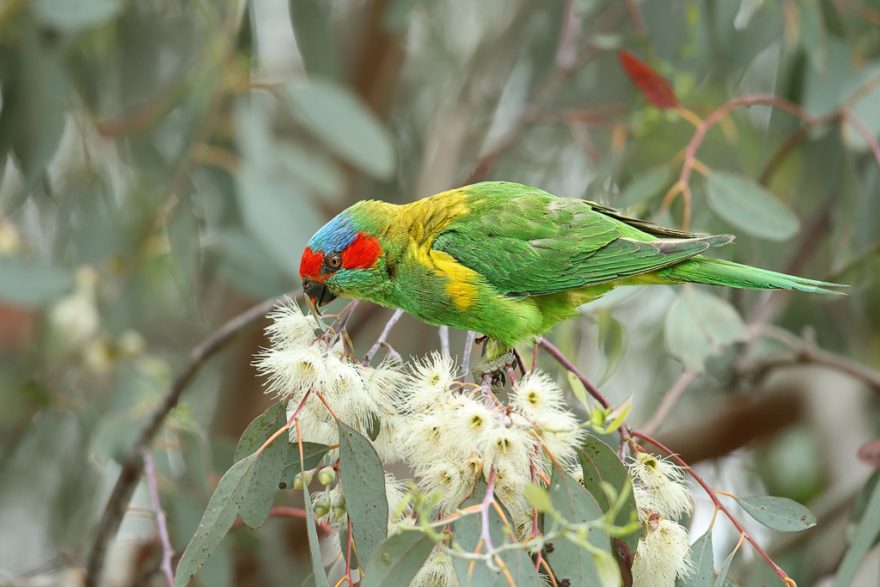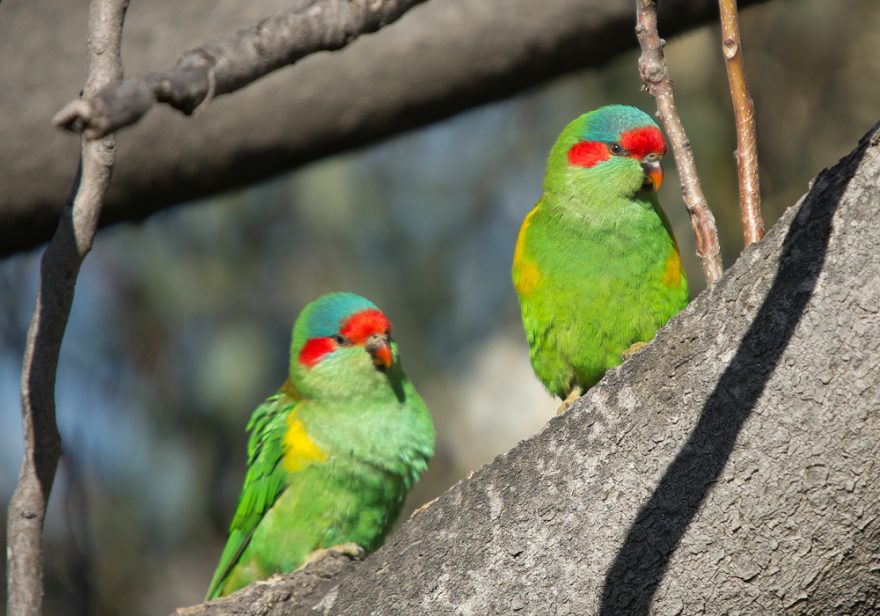The Musk lorikeet is a medium sized lorikeet native to south-central/eastern Australia. They predominantly live in eucalyptus trees, which provide them food, shelter and nesting locations. Musk lorikeets are uncommon in aviculture, with commercial availability generally limited to areas in which the species naturally occurs.

Diet & Feeding
Lorikeets possess a brush tipped tongue which is used to extract nectar and pollen from flowering trees. In captivity; a commercial lorikeet mix and a variety of fruit and vegetables is acceptable. Apple, pear, grapes, tomato and strawberries are particularly enjoyed.
Commercial lorikeet mixes can often be fed dry (in powder form) or wet (mixed with water). Dry food and fresh water should be available at all times, as wet lorikeet food spoils quickly and needs to be replaced several times a day – especially in hot weather.
Lorikeets should not be permitted to consume seed, as it can damage the brush tip on their tongue and contribute to a variety of health issues; many of which lead to a reduced lifespan.
Housing & Compatibility
Due to their high-moisture diet, Lorikeets produce a large amount of liquid faeces. A cage or aviary that prevents birds from being able to touch their droppings is essential. This reduces exposure to dangerous bacteria and parasites. Frequent cleaning is necessary and the aviary should be designed to accommodate this. A substrate of sand or gravel that can easily be replaced or pressure-cleaned is needed in traditional style aviaries. Many breeders use suspended flights; which allow droppings to fall through the bottom.
Lorikeets are poor at vertical flight, so an aviary at least 3m in length is recommended. Perches should be placed as far apart as possible to encourage distance flight.
Musk Lorikeets are generally placid and can be kept with doves, finches and other parrots. They may become assertive in a confined space or during the breeding season, at which point multiple feeding stations or a second aviary may be needed to control aggression.

Breeding
Musk lorikeets will breed from mid-spring until the final weeks of summer, however breeding at other times of the year does happen. They typically produce one clutch of two chicks per season, but larger or more frequent clutches have been known to occur.
They will readily accept a wide variety of nest boxes in many different shapes and sizes. Hollow logs can also be used, ideally hung from the ceiling to limit access from vermin. The nest box should have a shallow bed of rotting wood, sawdust or pine shavings to provide cushioning. The large amount of liquid faeces produced by young birds will quickly soil the nest box, so it needs to be thoroughly cleaned between clutches. Some breeders drill small holes into the bottom of the next box to allow moisture to escape.
Musk Lorikeets will begin breeding at approximately one year of age. They will not breed unless there is a strong pair bond, signified by mutual preening and feeding. The male will begin the breeding process through a courtship display of bobbing and hopping. If copulation is successful, the female will lay two white eggs that she incubates for 24 days.
The chicks will fledge the nest at around 6-8 weeks of age. They become independent from their parents quite quickly, usually only taking a week or two. Watered-down wet lorikeet food can be provided to help young chicks learn to feed independently. Young birds can be kept with their parents indefinitely, however some aggression can occur in subsequent breeding seasons.
Sexing
Musk lorikeets are challenging to visually sex, so DNA sexing may be necessary. Males generally have brighter red and blue facial coloring and larger yellow patches beneath the wing. Some males have small flashes of orange feathers among their yellow patch. Males will also bop their heads when courting a mate.
Mutations
Musk lorikeet mutations are fairly uncommon. A dark green “olive” mutation is reasonable well established, while a pure yellow “lutino” mutation is exceedingly rare and valuable.
Most musk lorikeets with an unusual appearance are the result of interbreeding between different lorikeet species rather than true mutations.
As Pets
Musk Lorikeets are unusually easy to tame. Because they are biologically programmed to enjoy sweet foods, it’s possible to use berries or small pieces of fruit to gain their trust in a relatively short period of time. They do show occasional aggression towards humans. Their small size and nectar-suited beak make this aggression non-threatening and easy to correct.
Musk lorikeets are not known to talk, however they are quite skilled at mimicking sounds.
Health
Due to their high-moisture diet, lorikeets produce a large amount of liquid faeces. If aviary hygiene is not adequately maintained, bacterial and fungal infections can thrive. In traditional aviaries, keeping the substrate as dry as possible is essential. Ensure there is good drainage and a substrate—ideally sand—that can be frequently replaced.
Similarly, it’s important that a lorikeet’s food supply is not permitted to spoil. Fruits, vegetables, and “wet” lorikeet food should be removed on the same day as it’s placed in the aviary. In hot weather, food will spoil more quickly so it may be necessary to provide multiple feedings throughout the day.
A preventative worming and parasite control regime should be applied to ensure the long-term health of your birds.
A healthy musk lorikeet should have an expected lifespan of 12-20 years.